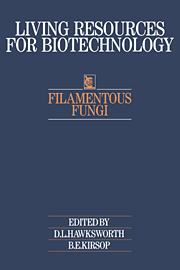Book contents
- Frontmatter
- Contents
- Contributors
- Series introduction
- Preface
- Acknowledgements
- 1 Resource centres
- 2 Information resources
- 3 Administration and safety
- 4 Culture and preservation
- 5 Identification
- 6 Patent protection for biotechnological inventions
- 7 Culture collection services
- 8 Organisation of resource centres
- Appendix: Media
- References
- Index
1 - Resource centres
Published online by Cambridge University Press: 04 August 2010
- Frontmatter
- Contents
- Contributors
- Series introduction
- Preface
- Acknowledgements
- 1 Resource centres
- 2 Information resources
- 3 Administration and safety
- 4 Culture and preservation
- 5 Identification
- 6 Patent protection for biotechnological inventions
- 7 Culture collection services
- 8 Organisation of resource centres
- Appendix: Media
- References
- Index
Summary
Nature of the resource
Although culture collections of filamentous fungi date back to the late nineteenth century and one of the largest of them, the Centraalbureau voor Schimmelcultures (CBS) in The Netherlands was established in 1904, rather little interest had been shown in their funding, and proposals to set up such collections often received only token support. With the advent of biotechnology the search for microorganisms which have properties suitable for commercial exploitation has led to a renewed interest in culture collections because of the appreciation of the valuable resource they represent.
The term ‘filamentous fungi’ is used for species producing filamentlike hyphae. It includes almost the entire fungal kingdom and is used in contradistinction to ‘yeasts’, which are essentially unicellular fungi with vegetative cells capable of repeated budding. The yeast fungi are not considered further here as they are treated in a companion volume in this series. While some fungus culture collections maintain both filamentous fungi and yeasts, most specialise in one growth form or the other. This is a consequence of the different uses made of them (and so of their relevance to particular industries), the diverse growth conditions, and the dissimilar ways in which they are currently characterised (physiologically and biochemically in the yeasts, but largely morphologically in all other fungi).
Precisely how many strains of filamentous fungi are maintained in the living state in culture collections throughout the world is unknown. However, the number certainly exceeds 170 000 scattered through over 200 collections, and it has been estimated that around 7000 different species are represented (Hawksworth, 1985a).
- Type
- Chapter
- Information
- Filamentous Fungi , pp. 1 - 30Publisher: Cambridge University PressPrint publication year: 1988



